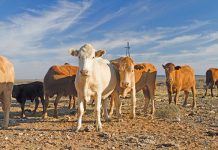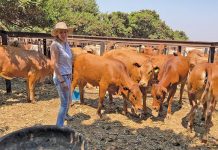
* Internal parasite infestations are on the increase throughout the country. Now is the time to be aware of outbreaks and check control programmes. Egg count reduction tests should be done to ascertain which anthelmintic groups are still controlling the roundworm infestation on the farm.
The active group is indicated by a number on the container:
| Group code |
Generic class of activities |
Examples of activities |
| 1. | Macrocyclic lactones | Abamectin, Doramectin, Eprinomectin, Ivermectin Moxidectin |
| 2. | Bensimidazoles (white drugs) | Albendazole, Ricobendazole, Fenbendazole, Febental, Triclabendazole |
| 3. | Imidathiazoles (clear drugs) | Levamisole, Morantel |
| 4. | Salicylanilides | Closantel, Niclosanide, Rafoxanide, Resorantel |
| 5. | Phenols | Clorsulon |
| 6. | Sulphonamides | Nitroxinyl |
| 7. | Organophosphors | Trichlorfon |
| 8. | Isoquinolones | Prasiquantel |
| 9. | Others: Amino-acetonitryl derivatives (AADs) | Pipirazine, Monepantel |
| 10. | Spiroindoles | Derquantel |
All animals that are bought should be quarantined, treated and then tested to ensure that their faecal egg counts have dropped to zero before introducing them into the flock.
* A large percentage of cattle has been infected with liver fluke in Middelburg and Standerton (Mpumalanga), and Frankfort and Villiers (Free State).
In Villiers the worst affected animals are those that were put to grazing in vleis or other low-lying areas with water sources. Water levels are lower and the concentration of snails, the intermediate hosts of the parasites, are higher.
The only active that controls liver fluke from a very young age is triclabendazole. Speak to your vet about tests to determine whether your animals are infested with liver flukes.
* An increase in the occurrence of coccidiosis and cryptosporidia has been reported. Ensure wet conditions are restricted to the minimum.
* Blue tick numbers are increasing and therefore the risk of outbreaks of Asiatic and African red water increases as well. Has the resistance status of the blue ticks on the farm to acaricides been established? Have the animals been vaccinated? Do you have a strategy to control ticks and tick-transmitted diseases? Now is the time to discuss strategy with your vet before outbreaks and economic losses occur.
* Outbreaks of anaplasmosis have been reported throughout the country. This disease should be controlled by vaccinating cattle at a young age and controlling biting flies and blue ticks, which also transmit the disease.
* Heartwater outbreaks were reported in the transition areas bordering the enzootic-stable areas. These include Mtubatuba and Dundee (KZN) and Middelburg and Volksrust (Mpumalanga).
In Dundee three to five animals died until blocking was achieved and dipping instituted. Most farms with outbreaks are on the border of the heartwater areas and it’s difficult to achieve a stable situation. Other areas have heartwater introduced through speculation.
In Volksrust, cattle brought in from the Lowveld were found to have heartwater ticks after a cow died of the disease.
Game such as kudus and warthogs are also spreading heartwater-infected bont ticks. Farm workers should be trained to recognise the first clinical signs of diseases and how to use a thermometer.
* Lumpy skin disease has been reported and animals should now have been vaccinated against insect-transmitted diseases such as blue tongue, Rift Valley fever, Wesselsbron, three day stiff sickness and horse sickness. Biting insects are more prevelant in low lying areas and can be controlled by using a pyrethroid such as deltamethrin.
* Despite regular reports of outbreaks of venereal diseases (trichomonosis, vibriosis, brucellosis, ram’s disease, peestersiekte) and advising farmers to contact their vets for help and advice, these diseases are still occurring. And millions are lost due to lower calving percentages, abortions and culling of genetic material.
* Every month deaths are reported due to clostridial diseases (gasgangrene, blood gut, red gut, enterotoxaemia, tetanus, botulism). These diseases can be controlled by vaccination, but farmers often make the mistake of not following up with the booster vaccinations. Discuss vaccination programmes regularly with your vet.
* Calf diseases caused by Escherichia coli, Salmonella Dublin and Serratia odeferans were reported. It’s important to get a diagnosis and to vaccinate cows with the relevant vaccines before calving so that the calf receives optimal protection through the colostrum.
* Opthalmia in cattle can be prevented to a great extent by vaccinating animals against Moraxella bovis and by practising fly control.
* It’s important to note that the bacteria Pasteurella multocida is isolated more and more as the cause of pneumonia in feedlots. (Please see Feedlot Report.)
* Many dystocias were reported and the main reasons were due to the pelvis of the heifer being too small or the calf being too big. Contact your vet so that pelvis measurements are done before the next breeding season and all female animals with too small pelvi are culled.
* Poisonings that were reported: urea, tulip, Lantana, gousiekte, Senecio, cardiac glycosides, rye grass and acidosis.
Feedlot report
Sheep:
- A few sheep died shortly after arrival with congenital defects – smaller lungs.
- Losses due to clostridial diseases.
- Deaths due to pulpy kidney and adaptation problems the main reason for deaths in new arrivals.
- Abattoir samples of pneumonias seen at abattoirs mostly due to Pasteurella multocida.
Cattle:
- Losses due to botulism occurred in three areas. One had had veld fires and skeletons lying in the veld were the source of the botulism.
- Dust and fluctuating temperatures led to predisposition to pleuritis.
- Lumpy skin disease seen in two feedlots even before the vectors increased in numbers.
- Snotsiekte was seen where cattle had contact with blue wildebeest.
- Abortions occurred in a stud herd and a calf was born blind. Suspect BVD. Samples sent to a laboratory for diagnosis.
Click on the link to view disease outbreaks in the your region.













